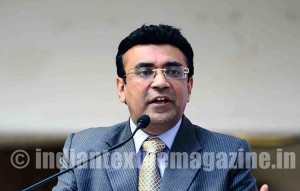Mr. Sanjay K. Jain, Chairman, CITI, welcomes 28% hike in Minimum Support Price (MSP) of Cotton announced by the Government of India. The Government has taken the decision to ensure farmers get at least 50% profit of their actual cost of production. According to Mr Sanjay Jain, “At one level, the move would certainly increase farmers’ income, leading to an increase in domestic consumption that would eventually support the overall Indian economy. However, we need to examine the event from different perspectives and understand that lakhs of farmers gain should not impact the USD 120 billion industry which employs directly and indirectly more than 10 crore people”.

From 2009-10 to 2017-18, MSP increased by Rs.1320/quintal and in 2018-19, it has been increased by Rs.1130/quintal. The impact is huge and possibly unprecedented. The Textile & Clothing being an integrated industry, the proposed hike in MSP based on 1.5 times the A2+FL costs would impact each segment along the supply chain raising the final price of the product. Further, this intervention would also make Indian cotton fibre relatively expensive with respect to international prices. As T&C exports are still reeling under the pressure to perform, absorbing a hike of 28% would be difficult for the entire textile Industry. Although, China has imposed an additional 25% import duty on American cotton and the rupee has also depreciated against the dollar, still cotton and yarn would face headwinds.
Mr. Jain emphasised that the real impact depends on the movement of international prices of cotton. In case, prices stay above MSP, there will be no issue. However, if prices fall below it, the impact would be severe. The industry is fully integrated with the global market and India being a significant player, cannot work in isolation. Post 2008 recession, Indian MSP was higher than international prices which finally led to a huge loss to the industry and exports dipped significantly.
Mr. Jain pointed out that higher MSP would further compel huge cotton procurement by the state-run Cotton Corporation of India (CCI). In the past, for instance, the Centre raised cotton MSP (medium staple) by a record 39% in 2008-09, driving up CCI’s procurement to an all-time-high of 8.9 million bales. Industry hopes that a clear CCI Policy is spelt out, so that in case they need to make massive procurement, the industry gets regular offering from them throughout the season at international parity prices (system linking offered prices to ICE may be formulated).
He pointed out that while it is very important that farmers earn reasonable profit above their costs, it’s also important to ensure that the industry gets internationally competitive raw material. The industry has been requesting for a direct subsidy scheme for farmers to be considered at least partly, so that, while 50% profit over the so-called A2+FL cost is assured to the farmers and the Industry also remains competitive by cotton fibre prices being determined by demand and supply. This would ensure that employment in the labour-intensive T&C industry isn’t affected and the growth targets of output, export and employment are met.
It is pertinent to mention here that a few years back, China had also increased their buying price from farmers significantly which made their domestic prices much higher than the international prices leading to Chinese Government accumulating almost 50% of the global cotton which it is still liquidating even after 5 years. This led to the cotton yarn industry becoming unviable and imports of cotton yarn zoomed from India, Vietnam and Pakistan. The Chinese Government realised that holding cotton by buying at higher price isn’t a solution and hence, a couple of years back, it shifted to a direct subsidy route which has made the Chinese cotton industry again competitive and also reduced the Government burden of stocking high priced cotton and then selling it at a loss.
We hope our Government, would devise some direct subsidy route so that interests of both farmers and the largest industrial employer are equally protected for a win-win situation. Textile industry has the huge potential to provide employment to the masses, especially rural women, if it increases its export competitiveness to effectively compete with Bangladesh and Vietnam (their garment exports are almost double than that of India). China recently announced concessions on 8000 items under APTA, however, none of the Indian textile products got any relief – hence, the industry is not getting a level playing field in any of the major markets.
Thus, while hike in MSP is indeed a welcome move, yet textile industry requests the government to put in place a delivery mechanism so that industry that is already reeling under the pressure gets the raw material at reasonable prices.